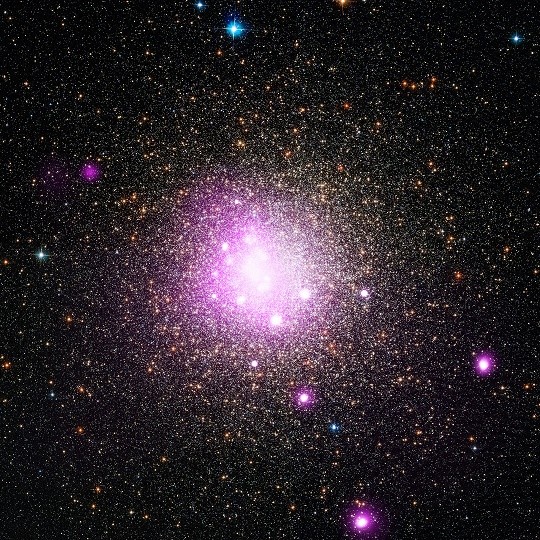Death Star? White Dwarf Destroys a Passing Planet
| Ana Verayo | | Apr 20, 2015 09:02 AM EDT |
(Photo : X-ray: NASA/CXC/IASF Palermo/M.Del Santo et al; Optical: NASA/STScI) Globular cluster NGC 6388 hosts a white dwarf that could have destroyed an entire planet.
NASA's Chandra X-ray Observatory along with other telescopes have found evidence a white dwarf has been killing off planets.
With the aid of the European Space Agency's INTErnational Gamma-Ray Astrophysics Laboratory (INTEGRAL), scientists have detected a new X-ray source emanating from the center of a globular cluster called NGC 6388.
Like Us on Facebook
Prior observations have suggested this particular cluster hosts an intermediate mass black hole in its center. The X-ray detection also suggests they were produced by hot swirling gas in the direction of the black hole.
Follow up observations from Chandra determined these X-rays apparently don't originate from the black hole in the center of NGC 6388 but from another region located sideways. Since it has been ruled out the central black hole is emitting these X-rays, scientists began to search for the source of these emissions. They resorted to the X-ray telescope aboard NASA's Swift Gamma Ray Burst mission for further analysis.
Upon observing closely, scientists found the source had become dimmer when the rate of the X-ray brightness decreased. This new finding also correlated with theoretical models from a planet disruption caused by gravitational tidal forces from a white dwarf.
White dwarfs are stars roughly the same size as Earth but how can a relatively small star wipe out and destroy an entire planet? This was apparently caused by massive forces of gravity from the star.
As a star reaches a white dwarf age, its core and other material become compact and are reduced to a radius of just one percent of its original size. This density causes powerful forces generated from its equally massive gravitational forces.
Theoretical models suggest a planet can be pulled away from its host star by the extreme gravity of a passing white dwarf. When a planet gets too close, it can be ripped apart, obliterated by gravitational tidal forces from the ultra dense star.
NASA said this planetary debris becomes heated, glowing in X-ray emissions as it falls into the white dwarf. This conclusion was based on evidence of the X-ray amount and different X-ray energies detected from that particular tidal disruption event.
The destroyed planet would have possessed a mass one third of Earth's and the white dwarf had 1.4 times the mass of our Sun.
TagsDeath Star? White Dwarf Destroys a Passing Planet, death star, NASA, chandra telescope, NASA swift gamma ray, white dwarf, white dwarf killed destroyed passing planet
©2015 Chinatopix All rights reserved. Do not reproduce without permission
EDITOR'S PICKS
-

Did the Trump administration just announce plans for a trade war with ‘hostile’ China and Russia?
-

US Senate passes Taiwan travel bill slammed by China
-

As Yan Sihong’s family grieves, here are other Chinese students who went missing abroad. Some have never been found
-

Beijing blasts Western critics who ‘smear China’ with the term sharp power
-

China Envoy Seeks to Defuse Tensions With U.S. as a Trade War Brews
-

Singapore's Deputy PM Provides Bitcoin Vote of Confidence Amid China's Blanket Bans
-

China warns investors over risks in overseas virtual currency trading
-

Chinese government most trustworthy: survey
-

Kashima Antlers On Course For Back-To-Back Titles
MOST POPULAR
LATEST NEWS
Zhou Yongkang: China's Former Security Chief Sentenced to Life in Prison

China's former Chief of the Ministry of Public Security, Zhou Yongkang, has been given a life sentence after he was found guilty of abusing his office, bribery and deliberately ... Full Article
TRENDING STORY

China Pork Prices Expected to Stabilize As The Supplies Recover

Elephone P9000 Smartphone is now on Sale on Amazon India

There's a Big Chance Cliffhangers Won't Still Be Resolved When Grey's Anatomy Season 13 Returns

Supreme Court Ruled on Samsung vs Apple Dispute for Patent Infringement

Microsoft Surface Pro 5 Rumors and Release Date: What is the Latest?










